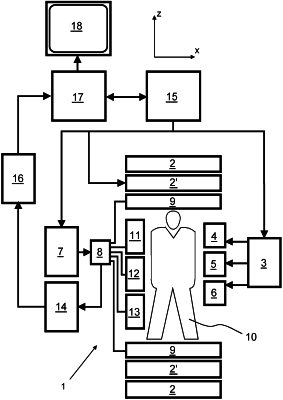| CPC G01R 33/5608 (2013.01) [G01R 33/4818 (2013.01); G01R 33/5607 (2013.01); G01R 33/5611 (2013.01); G01R 33/5616 (2013.01); G01R 33/5618 (2013.01); G01R 33/56509 (2013.01)] | 20 Claims |

|
1. A method of magnetic resonance (MR) imaging of an object positioned in an examination volume of a MR device, the method comprising:
a) generating MR signals by subjecting the object to a 3D radial imaging sequence comprising RF pulses and switched magnetic field gradients defining a field-of-view and including a number of shots of a multi-echo imaging sequence, each shot comprising an RF excitation pulse followed by a number of refocusing magnetic field gradients or refocusing RF pulses to generate a train of MR echo signals in rapid succession, wherein each MR echo signal corresponds to one k-space profile and wherein k-space profiles from one k-space segment are acquired during one shot of the multi-echo imaging sequence, with a different k-space segment being associated with each shot;
b) for an individual k-space segment acquiring the MR signals as radial k-space profiles for a first group of k-space profiles at a first rotation angle and subsequently for a second group of k-space profiles at a second rotation angle, wherein the second rotation angle is incremented relative to the first rotation angle by a minimal angle φ to fulfill Nyquist criterion according to the field-of-view, and wherein the k-space profiles of the first and second groups are acquired in opposite directions; and
c) reconstructing an MR image from the acquired MR signals.
|